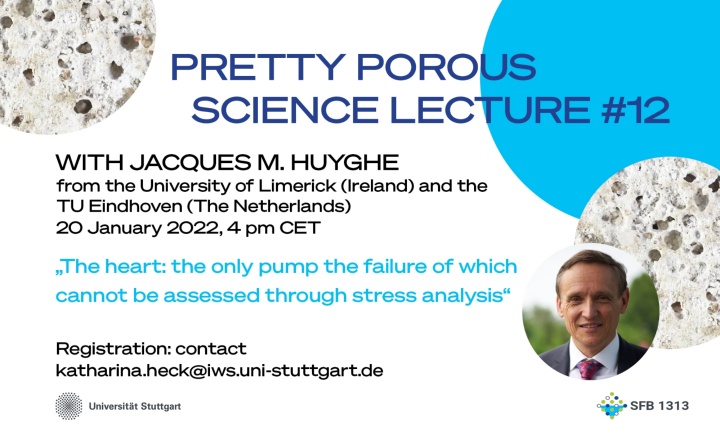We are pleased to announce that Jacques M. Huyghe, professor at the University of Limerick (Ireland) and the Eindhoven University of Technology (The Netherlands), and holder of the InterPore Kimberly-Clark Distinguished Lectureship 2022, will give the SFB 1313 "Pretty Porous Science Lecture" #12. His talk will be on "The heart: the only pump the failure of which cannot be assessed through stress analysis".
Date: Thursday, 20 January 2022
Time: 4:00 pm CET
Speaker: Prof. Dr. Jacques M. Huyghe
Lecture title: "The heart: the only pump the failure of which cannot be assessed through stress analysis"
Place: If you are interested in participating in the lecture, please contact katharina.heck@iws.uni-stuttgart.de
Abstract
Technological advances in computational mechanics allow to simulate failure of any part of airplanes, pumps, compressors, electric power stations, foundations, bridges, etc. Billions of dollars have been invested to calculate 3D stress configuration in engineering structures. Why stress? Because the criterion of failure in engineering structures is generally excess stress. Failure of the human heart is responsible for 6 million deaths per year worldwide. Models of cardiac mechanics have been developed to analyse cardiac pump function from tissue to organ scale. All of these models focus on stress and strain. [9] However, heart failure is not associated with fracture. Failure of a heart is usually induced by a mismatch between blood perfusion and metabolic needs of the cardiomyocytes. Blood perfusion is defined as the capillary blood flow per unit volume of tissue. Its dimension is ml s-1ml-1=s-1. Typical values at rest are 0.02 s-1[7]. Blood flows into the myocardium through a complex tree of arterial vessels, reaching a dense network of more than 3000 capillaries per mm2. A tree of venous vessels mostly parallel to the arterial tree drains the blood. Because failure is associated with blood perfusion and present day models do not address this failure mechanism [9], there is an urgent need for a computational strategy for blood perfusion in deforming myocardial tissue. Upscaling of the vessel trees [1-3,5] opens the way to computation of coronary blood flow in a multi compartment poro-mechanical model of the beating heart. Arterial, arteriolar, capillary, venular and venous blood are treated as separate compartments [3-8]. As a result, the supply of oxygen to the tissue is modelled. Combining this with a local metabolism and autoregulation, a precise criterion of failure is implemented to predict cardiac pathologies and the impact of interventions on heart function. Through the design of a virtual environment for testing cardiac interventions, the time to market of all newly designed devices and therapies will be shortened substantially.
About Jacques M. Huyghe
Jacques Huyghe holds a Master degree in Civil Engineering from Ghent University, Belgium (1979) and a Ph.D. from Eindhoven University of Technology, The Netherlands. Jacques Huyghe has a unique signature in that he has been working at the interface between biomedical and petroleum engineering. He advertised repeatedly the close analogies between biological tissues and geomaterials and the urgent need to exploit these analogies in developing numerical models and industrial/clinical technologies. He authors more than 125 full-size SCI-publications, is the recipient of many awards among which a Royal Dutch Shell donation (1995-1998), a fellowship of the Royal Netherlands Academy of Arts and Sciences (1996-2001) and a swelling materials Interpore Award (2013). He has been cooperating with many industrial partners among which Philips Research, Shell Research and Procter and Gamble. His present interest is in mechanotransduction through voltage gated ion channels in intervertebral disc, swelling and fracture of superabsorbents and poromechanical modelling of coronary blood flow and microvascular flow of red blood cells.



